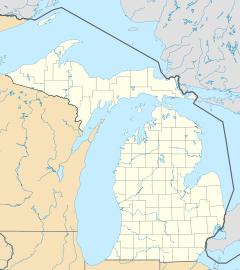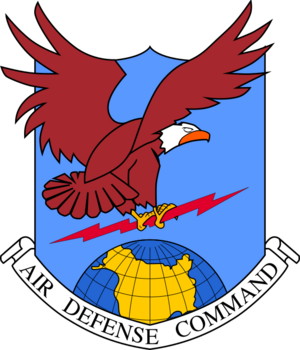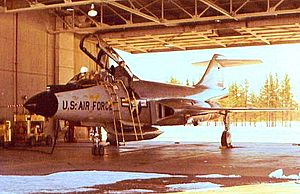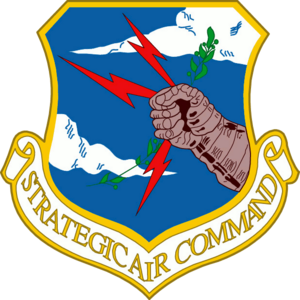K. I. Sawyer Air Force Base facts for kids
Quick facts for kids K. I. Sawyer Air Force Base
|
|
|---|---|
| Part of Strategic Air Command | |
| Marquette County, near Marquette, Michigan | |

28 April 1998
|
|
|
Location in Michigan
|
|
| Coordinates | 46°21′13″N 87°23′43″W / 46.35361°N 87.39528°W |
| Type | Air Force Base |
| Site information | |
| Controlled by | U.S. Air Force |
| Site history | |
| Built | 1944 |
| In use | 1955–95 |
| Events | Cold War |
| Garrison information | |
| Garrison | 410th Bomb Wing |
|
Airfield information
|
|||||||||||
|---|---|---|---|---|---|---|---|---|---|---|---|
| Summary | |||||||||||
| Elevation AMSL | 1,221 ft / 372 m | ||||||||||
| Coordinates | 46°21′13″N 087°23′43″W / 46.35361°N 87.39528°W | ||||||||||
| Runway | |||||||||||
|
|||||||||||
|
K.I. Sawyer AFB, Michigan
|
|
|---|---|
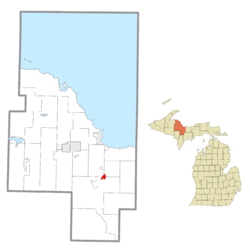
Location within Marquette County
|
|
| Country | United States |
| State | Michigan |
| County | Marquette |
| Townships | Forsyth and West Branch |
| Area | |
| • Total | 1.73 sq mi (4.49 km2) |
| • Land | 1.71 sq mi (4.43 km2) |
| • Water | 0.02 sq mi (0.05 km2) |
| Elevation | 1,158 ft (353 m) |
| Population
(2020)
|
|
| • Total | 3,064 |
| • Density | 1,789.72/sq mi (691.21/km2) |
| Time zone | UTC-5 (Eastern (EST)) |
| • Summer (DST) | UTC-4 (EDT) |
| ZIP Code |
49841 (Gwinn)
|
| Area code(s) | 906 |
| GNIS feature ID | 2393067 |
K. I. Sawyer Air Force Base was a military base in Marquette County, Michigan. It was a United States Air Force (USAF) site located south of the city of Marquette. This base was active for almost 40 years before it closed in 1995.
Today, part of the old base is used as Sawyer International Airport. This airport has regular flights and is also used for general aviation. The area where the base used to be is now a community called K. I. Sawyer. In 2020, about 3,064 people lived there. It is located in Forsyth and West Branch townships, about 16 miles (26 km) south of Marquette.
Contents
History of K. I. Sawyer Air Force Base
The story of K. I. Sawyer Air Force Base began in the 1930s. A man named Kenneth Ingalls Sawyer, who was a civil engineer and road commissioner, wanted to build an airport. He thought an airport would help the Marquette area grow. The local mining industry was expanding, and more travel was needed. By 1937, a county airport was built between Marquette and Negaunee.
By 1940, Sawyer realized the Negaunee airport was getting too busy. In 1941, a plan for a new airport was presented. The chosen spot had a large sand hill and many blueberry patches. The local board agreed to the idea. Soon after, the United States entered World War II. People in the area worried about protecting the important Soo Locks at Sault Ste. Marie. They suggested the U.S. Army Air Forces take over the new airfield, but this idea was put on hold.
Early Airport Days
Kenneth Ingalls Sawyer passed away in 1944. The next year, the airfield was finished and named K. I. Sawyer Airport in his honor. It had one airstrip and was first used by private pilots. In 1948, Nationwide Airlines became the first commercial airline to fly from there. They offered flights to Detroit, stopping in other Michigan cities like Escanaba.
In February 1954, the U.S. Air Force announced plans to expand. They needed new bases. The government talked with Marquette County about leasing Sawyer's airport. They offered to build a $12 million jet base that both the Air Force and civilians could use. One rule was that civilian planes could only land up to 300 times a month. In January 1955, a public meeting was held. Many people wanted the county to accept the government's offer.
Becoming an Air Force Base
On January 24, 1955, the U.S. government signed a 99-year lease for the airport. Construction of military buildings started right away. About 850 people worked on building the base. The Secretary of the Air Force said that over 900 military personnel would be stationed there.
K. I. Sawyer Airport officially opened as a shared civil-military facility on April 8, 1956. Soon, the Air Force suggested building a new civilian airport in Negaunee Township. This would allow the Air Force to have K. I. Sawyer all to itself. The Air Force built a very long and wide runway, measuring 12,366 feet (3,769 m) long and 300 feet (91 m) wide. This large runway made it easy and safe for many planes to operate. K. I. Sawyer Air Force Base officially opened as a military-only base on May 8, 1959.
Air Defense Operations
When K. I. Sawyer Air Force Base first opened, it was part of the Air Defense Command (ADC). Its main job was to protect against enemy bomber attacks. The first planes assigned to Sawyer were F-102 Delta Daggers in 1958.
In 1958, the Sault Sainte Marie Air Defense Sector (SsmADS) was set up at K. I. Sawyer AFB. This group's job was to run the Semi-Automatic Ground Environment (SAGE) Data Center. The SAGE system was a network of radar stations that gave early warnings of a possible Soviet nuclear attack. It helped guide interceptor planes to stop any threats.
In 1959, the runway was made even longer. The base then received McDonnell F-101 Voodoo jets. These planes helped the SAGE system by being able to intercept and destroy enemy aircraft.
In 1964, the Strategic Air Command (SAC) took over control of the base. The Air Defense Command's presence at Sawyer became smaller. In 1971, the F-101 jets were replaced with F-106A Delta Dart jets flown by the 87th Fighter Interceptor Squadron. These planes were kept ready 24/7 in case of an attack.
By 1985, the 87th Fighter Interceptor Squadron was closed down. The job of defending the skies was increasingly given to the Air National Guard. The last F-106 jets left K. I. Sawyer in September 1985. Many of these planes were later turned into target drones and used for practice.
Strategic Air Command Operations
The Strategic Air Command (SAC) became a major part of K. I. Sawyer AFB in 1958. The base became home to the 4042d Strategic Wing. This wing was a "dispersal wing" for B-52H Stratofortress bombers. This meant that the large bombers were spread out among many bases. This made it harder for an enemy to destroy the entire fleet in a surprise attack.
Before the B-52s arrived, a very strong concrete runway was built. It was 24 inches (61 cm) thick and 150 feet (46 m) wide. It was extended to 12,366 feet (3,769 m) long in 1959. The base also received KC-135A tanker planes, which were used to refuel other aircraft in the air.
In 1963, the 4042d Strategic Wing became the 410th Bombardment Wing. Its mission remained the same: to be ready for combat at all times. K. I. Sawyer was one of three SAC bases in Michigan that had B-52 bombers.
The 410th Bomb Wing's job was to keep its planes and crews ready. This included maintaining aircraft, training bombing crews, and supporting air refueling. The B-52H bombers at Sawyer were used for strategic deterrence, meaning they were ready to prevent an attack by showing strong defense. However, the tanker planes and their crews from Sawyer did participate in missions during the Vietnam War.
One KC-135A tanker from Sawyer became famous for running out of fuel just before landing. The crew, except for the instructor pilot, parachuted out. The instructor pilot managed to land the plane safely just short of the runway. The plane was repaired and put back into service.
Later, in the early 1980s, K. I. Sawyer's B-52s were changed to carry the new AGM-86 Air-Launched Cruise Missile (ALCM). These missiles could be launched from the plane. In 1980, two B-52H crews from Sawyer won the Mackay Trophy for flying a nonstop, around-the-world mission. Their goal was to find and photograph Soviet Navy ships in the Persian Gulf.
Closure of K. I. Sawyer AFB
In 1993, the Base Realignment and Closure Commission (BRAC) recommended that K. I. Sawyer Air Force Base be closed. This commission decides which military bases should be closed or reorganized.
The KC-135 tanker planes left in October 1993. The B-52H bombers were sent to other B-52 bases. The last B-52 from Sawyer left in November 1994. The base officially closed at the end of September 1995.
The closure of K. I. Sawyer had a big negative impact on the economy of Michigan's Upper Peninsula. The base and the area around it were like the second-largest city in the Upper Peninsula, with 12,000 people. The U.S. Air Force spent about $157 million in the region each year. When the base closed, about 5,000 jobs were lost, and 14,000 residents moved away.
Legacy of K. I. Sawyer
K. I. Sawyer was a well-liked base among the Strategic Air Command. Even though it was isolated and far north, people enjoyed its location in the North Woods. There were many outdoor activities nearby, like hunting, fishing, boating, and winter sports such as skiing at Marquette Mountain. The base also had its own lake and ski hill.
Some people jokingly called the base "K. I. Siberia" because of the large amount of lake-effect snow. However, it didn't have the extremely cold temperatures of bases in North Dakota. Locals also said that the K. I. Sawyer runway was built over some of the best blueberry fields in the state. Blueberry patches could still be found in other parts of the base, and families often picked them.
Today, a part of the old K. I. Sawyer AFB has become Sawyer International Airport. This airport opened its passenger terminal in September 1999. It replaced the smaller Marquette County Airport as the main civilian airport for the region.
A group of local citizens has worked to preserve the history of the base. They have collected six aircraft that were used at the base over the years. These planes are displayed near the airport as part of the "Sawyer 6" project. The K. I. Sawyer Heritage Air Museum also has exhibits in the base's former recreation center.
Previous Names
- K. I. Sawyer Airport: April 8, 1956
- K. I. Sawyer Air Force Base: May 8, 1959 – September 30, 1995
Major Commands Assigned
- Air Defense Command (ADC): April 8, 1956
- Strategic Air Command (SAC): January 1, 1964
- Air Combat Command (ACC): June 1, 1992 – September 30, 1995
Main Units Stationed Here
|
|
Geography and Location
The airport terminal at K. I. Sawyer is about 1,190 feet (363 m) above sea level. This is about 600 feet (180 m) higher than Lake Superior, which is about 15 miles (24 km) north.
The community of K. I. Sawyer covers about 1.73 square miles (4.49 km2). Most of this area is land, with a small amount of water. The community is located within Forsyth and West Branch townships.
Population and People
| Historical population | |||
|---|---|---|---|
| Census | Pop. | %± | |
| 1970 | 6,679 | — | |
| 1980 | 7,345 | 10.0% | |
| 1990 | 6,577 | −10.5% | |
| 2000 | 1,443 | −78.1% | |
| 2010 | 2,624 | 81.8% | |
| 2020 | 3,064 | 16.8% | |
In 2020, the population of K. I. Sawyer was 3,064 people. This was an increase from 2,624 people in 2010.
In 2000, there were 1,443 people living in the area. About 55.1% of households had children under 18. The average household had 2.88 people. The median age was 25 years old.
The median income for a household in 2000 was $26,550. About 26.6% of the population lived below the poverty line.
Images for kids



